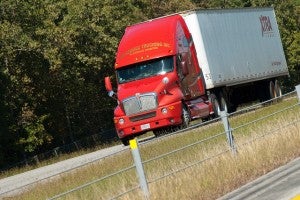A Win for Cleaner Air and a Stronger Economy: Court Dismisses Challenges to Fuel Efficiency and Greenhouse Gas Standards for Big Trucks

Today, the U.S. Court of Appeals for the Washington D.C. Circuit dismissed challenges to America’s historic, first-generation standards to improve fuel efficiency and reduce greenhouse gas emissions from large trucks and buses.
The Environmental Protection Agency (EPA) and Department of Transportation (DOT) standards are based on common sense, highly cost-effective technologies that will make our nation’s fleet of large trucks and buses more efficient while also reducing harmful, climate-destabilizing pollution, limiting our dependence on foreign oil, and saving money for both truckers (in the form of lower fuel costs) and all Americans (in the form of lower shipping costs).
These cross-cutting benefits have won broad-based support for the standards — including support from America’s truck and engine manufacturers, from states, and from public health and environmental groups.
In response to President Obama’s announcement of these first generation standards in 2011, many of these organizations sent letters of support. Here are just a few examples:
Cummins Inc. recognizes the benefits for the country of a National Program to address greenhouse gases (OHOs) and fuel efficiency from medium and heavy-duty trucks and buses. Cummins fully supports the adoption of such a National Program and welcomes this opportunity to be a partner in helping to advance that goal.
– Cummins Inc.
[Daimler] is committed to working with EPA and NHTSA, the states, and other interested parties to help address three of the most pressing issues facing the U.S. today and into the future: greenhouse gas reductions, fuel efficiency improvements, and increased energy security.
– Daimler Trucks North America
These standards apply to vehicles manufactured between 2014 and 2018. That means they are now in their second year of effectiveness, and they are driving technological innovations that are cleaning our air and helping American truck manufacturers to thrive. Through October of 2014, sales of fuel efficient trucks were 20 percent higher than their 2013 levels. 2015 is projected to be even stronger, with forecasts suggesting it will be the third strongest year ever for truck sales.
Martin Daum, president and CEO of Daimler Trucks North America, put it succinctly:
[These standards] are very good examples of regulations that work well.
That is very good news, because the President has announced that EPA and DOT will soon issue second-generation greenhouse gas and fuel efficiency standards for large trucks. We anticipate that those standards will be proposed late this spring or early in summer.
Many of the same companies that stood with the President in announcing a blueprint to develop the second phase standards also collaborated on the first generation clean trucks standards. Among those supporting the President’s announcement of second phase standards are major U.S. manufacturers and fleets such as Conway, Cummins, Eaton, Wabash National, Waste Management and the American Trucking Association.
The second generation standards will create an important opportunity to further reduce greenhouse gases and enhance the fuel economy of our nation’s trucks.
EDF is calling on the Environmental Protection Agency and Department of Transportation to set new standards for heavy trucks that cut fuel consumption by 40 percent in 2025 compared to 2010. That equates to an average of 10.7 miles per gallon for new tractor-trailer trucks. Technology solutions are available today to meet the goal, and strong standards will further drive innovation.
In fact, Daimler Trucks North America may have provided the best example yet of our future potential with its entry in the Department of Energy Super Truck program. Daimler announced that its team has:
[A]chieved 115 percent freight efficiency improvement, surpassing the Department of Energy program’s goal of 50 percent improvement.
Daimler’s truck registered 12.2 miles per gallon recently – a leap above the six miles per gallon typical of pre-2014 trucks.
Rigorous second generation standards will also secure critical benefits:
- Using these technologies will save us all money — Trucking fleets stand to see lower lifecycle costs and reasonable paybacks; consumer goods companies and other manufacturers stand to save money when shipping their products to market; and every U.S. household stands to save hundreds of dollars a year in lower priced goods.
- We have an urgent need for deploying these technologies — Heavy trucks account for hundreds of millions of tons of U.S. climate pollution and are the single fastest growing end-use source of emissions – on pace to add nearly 150 million more tons annually over the coming years.
When Americans stand together, we can forge big gains in strengthening our economy and protecting our environment.












